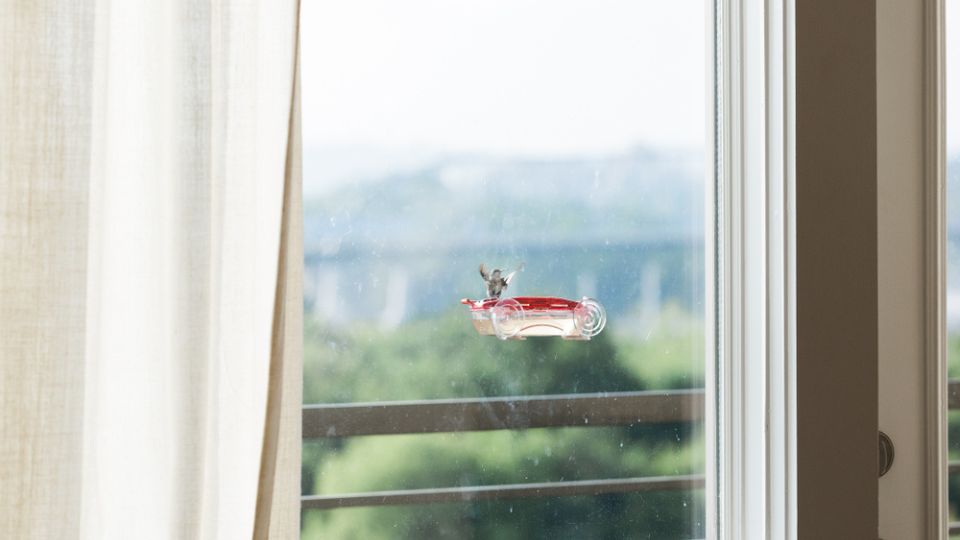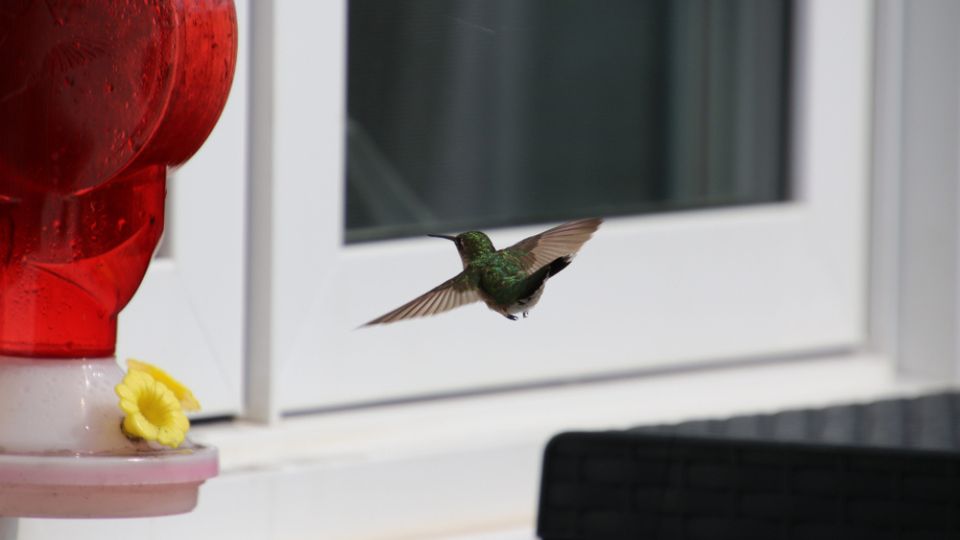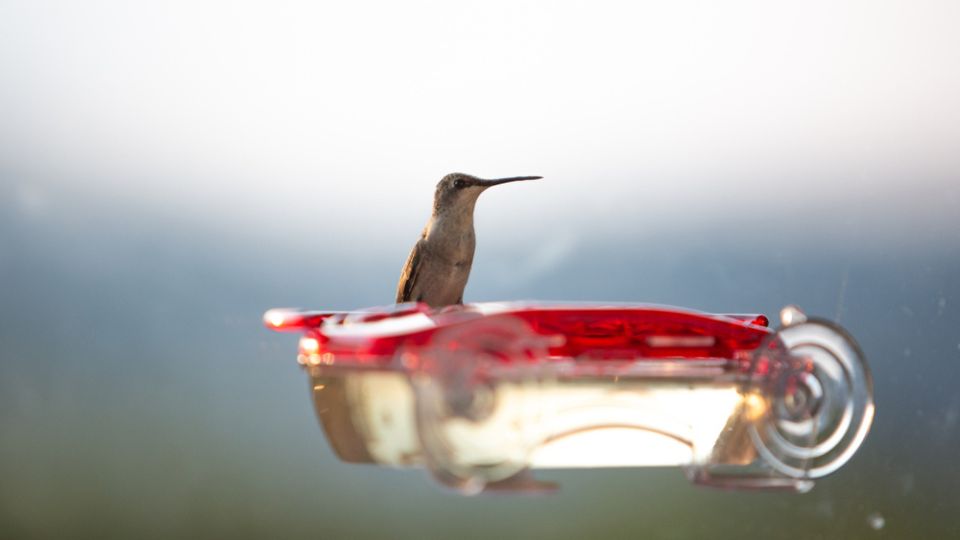Making your own windowhummingbird feeder is a great way to save money and attract hummingbirds right to you. Go with either a glass bottle, which requires a more robust hanger, or plastic, which you can attach with a suction cup. Both are equally easy to make and don’t require much knowledge.
If you get stuck with this little DIY project, you can always order a hummingbird window feeder. We listed some below for your convenience. Check them out.
Table of Contents
Are Window Bird Feeders OK?
Window bird feeders are one of the best ways to keep hummingbirds nearby. Hanging the feeder close to the window keeps the birds safe since they’ll know in which direction they’ll need to fly if scared. Plus, hanging a feeder near a window will prevent window collisions.
On the other hand, some people complained that a
Will Hummingbirds Come to a Window Feeder?
You can post your feeder near the living room, bedroom, or kitchen window, and these wild birds will still find it and come. Plus, you might get some other birds that drink nectar, like orioles. All in all, offering additional bird food to hummingbirds will keep them around.
Remember, hanging your feeders up during cold weather helps wintering hummingbirds survive. Many of these species of hummingbirds are territorial, so try to post several feeders around your yard. Many food sources will help them keep the peace.
Where Should a Hummingbird Feeder Be Placed in a Window?
Even though you may want to be close to the birds, you should still ensure the feeders are posted high and far enough from the window. Hanging them high will prevent cats and other predators from reaching them. You’ll generally want to hang the feeder about 15 feet away from the windows, reducing fatal collisions.
Additionally, keep in mind that more sun could result in spoiled nectar. Try to find a shady area to hang your feeder. Let the feeder receive morning sun and afternoon shade for optimal conditions.

How Do You Make a Window Hummingbird Feeder ?
Commercial window hummingbird feeders might be too heavy to hang. They might fall and break, and you’ll eventually get bored buying new ones. If you’re skilled in making handcrafted items, you can make your bottle of hummingbird feeders. There are several ways to do this.
Go can go for plastic ramekins or food containers. These should be marked food-grade; 2 or 5 should work fine. Plastic is light and will stay on your window even when filled with nectar. Use a wire and a suction cup to make a hanger. Paint the outside top of the lid with non-toxic paint. Make the wire longer, so the feeder is away from the window to prevent collisions.
If you want to make a glass window
Additionally, you’ll need:
- D-ring or carabiner
- Screw eye
- File
- Needle-nose pliers
- Wire cutter
- Hummingbird feeding tube
- Glass Bottle not larger than 375 ml (12 oz)
- Beads for decorations (optional)
Instructions:
- File the edges of the wires, so they’re not sharp.
- Bend the 4-gauge wire in two circles—one to hold the neck and the other to hold to the body of the bottle.
- Keep the wire loose enough so you can remove the bottle to clean it.
- Alternatively, use other wires to decorate with beads and shapes.
- Fill the bottle with nectar.
- Twist the feeding tube in the bottle gently.
- Hang the feeder upside down on a wire and carabiner.

How Do You Clean a Window Feeder?
You’ll clean the window feeder like you would any other. Inspect the nectar every 1 to 2 days. If you live in a hot area, you’ll probably clean it every other day. Colder weather will have you cleaning it about once a week.
Whenever the nectar levels go low, it’s time to check and clean your feeder. If you notice any buildup, black mold, or something floating in the hummingbird nectar, clean the feeder instantly. The more you do wash it, the easier it will be, and you’ll keep the hummingbirds safe.
Toss any remaining nectar and place your feeder in white vinegar and water solution or diluted dish soap. Let it sit for about an hour. Then scrub all the feeding ports, ant moats, the inside, and every tiny spot.
Ensure there’s no more mold and buildup, and rinse well. Let it dry, refill it with nectar, and hang it outside. If your feeder is dishwasher-safe, just pop it in there for a wash.
What Is the Best Type of Hummingbird Feeder to Use?
If you want to hang your feeder on the window glass, you’ll want to go for a plastic or glass
You can go with a window mount plastic
- Jewel Box Window
Hummingbird Feeder — Comes with a window mount. Easy to clean, has detachable ant moat, and is leakproof. - Droll Yankees Window Mount Feeder — It has a lifetime warranty, ruby-red feeder, window mounts, and a clear bottom to monitor nectar.
- Song Bird Gardens Feeders — Comes with patented HighView perch, engraved nectar scale, and multiple feeding ports. Secure to hang on the window and will hold well.
- Perky-pet Window Mount — Includes a glass bottle, window mounts, red perches, and a capacity for 14 oz of nectar.
- Mason Jar
Hummingbird Feeder — Possibly the sweetest feeder there is. Shaped like a tiny mason jar with a lid and red feeding stations on the side.

What Should a Hummingbird Feeder Be Made Of?
Before you order some of the best hummingbird feeders out there, check product details. They should be made of either glass or plastic since these materials won’t corrode. Plus, they’re easy to clean and durable. Acrylic feeders are also lightweight and great to hang on windows with only a suction cup.
Many feeders come in unique designs regardless of the material they’re made of. Most have red or yellow feeding ports with clear nectar storage. Nectar guard tips are optional. All these parts are made of safe plastic and are great for various birds, including hummingbirds.
If you decide to make your own feeder, go with clear plastic or glass bottles. Use food-grade plastic and non-toxic paint. Please stay clear of any metal in the feeder, as it can develop rust. Still, it’s completely safe to use metal hangers and wires.
Window Hummingbird Feeder Overview
With hummingbird feeders that hang on or near your window, you’ll have the freedom to look at hummingbirds without being in nature’s way. Window feeders will improve your birdwatching experience, as you’ll get to see how these birds eat and behave around food sources. Still, there are a few things to pay attention to.
Set up your feeders a bit farther from the window to avoid collisions. Check them regularly and clean them every 2 days to keep the birds healthy. Finally, set up multiple feeders around to help hummingbirds establish their territory without fighting.

